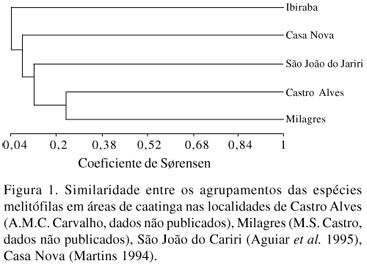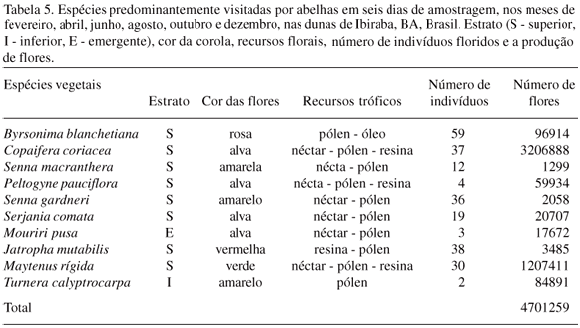The plant species in an area of caatinga vegetation (10º47'37'S and 42º49'25'W) were surveyed to identify flower morphology, available floral resources, flowering characteristics, and visiting bee species. Collections were made for four consecutive days in February, April, June, August, and December/2000. The area was surveyed between 06:00 and 17:00 h by following two parallel transects (450 m × 100 m and 550 m × 100 m), 50 m apart (total of 10 hectares). The 42 plant identified (55% of the local flora) were visited by a total of 2924 bees belonging to 41 species. The plant families Caesalpiniaceae and Malpighiaceae were the most frequently visited. The plant species most often visited by 35 species of bees (78% of the total number of bees surveyed) were: Byrsonima blanchetiana Miq., Copaifera coriacea Mart., Senna macranthera, Peltogyne pauciflora Benth., Senna gardneri (Benth.) H.S. Irwin & Barneby, Serjania comata, Mouriri pusa (Gardner), Jatropha mutabilis (Pohl.) Baill., Maytenus rigida Mart. and Turnera calyptrocarpa Urb. (24% of the total bee flora). These plant species were responsible for 95% of total flower production during the study period. Generally, the basic floral morphology of these species consisted of small, white to pink, zygomorphic flowers displayed in inflorescences, monoclinous, with longitudinal anthers dehiscence; this morphology was very similar to that of the flora, suited to generalist pollinators. The predominance of generalist interactions reflects the local abundance of stingless bees (Meliponinae) and Apis mellifera. Although flower production was greatest during the rainy season, bees were more abundant during the dry season. This indicates that bee activity was not limited by the availability of floral resources. Plants of the shrub stratatum flowered more intensely during the dry season, while herbaceous plants did so during the rainy season. This created a degree of compartmentalization of floral resources for the bees. This flowering pattern tends to favor small, solitary bees that cannot compete efficiently with eusocial bees (such as Apis mellifera) that have great capacity for communication and for exploiting the most abundant resources. The results indicate that it is not only the composition of the floral resources, but also the stratification and strong seasonal nature of flowering that influences the composition and local use by bees in caatinga vegetation.
caatinga; flowering; mellitophily; floral morphology; floral resources







